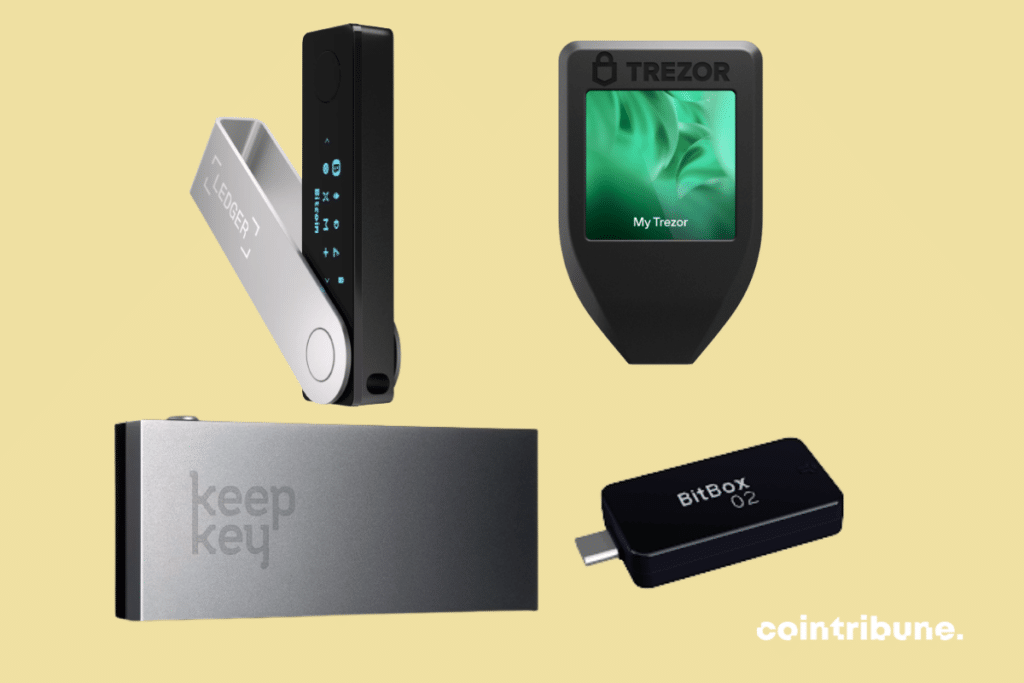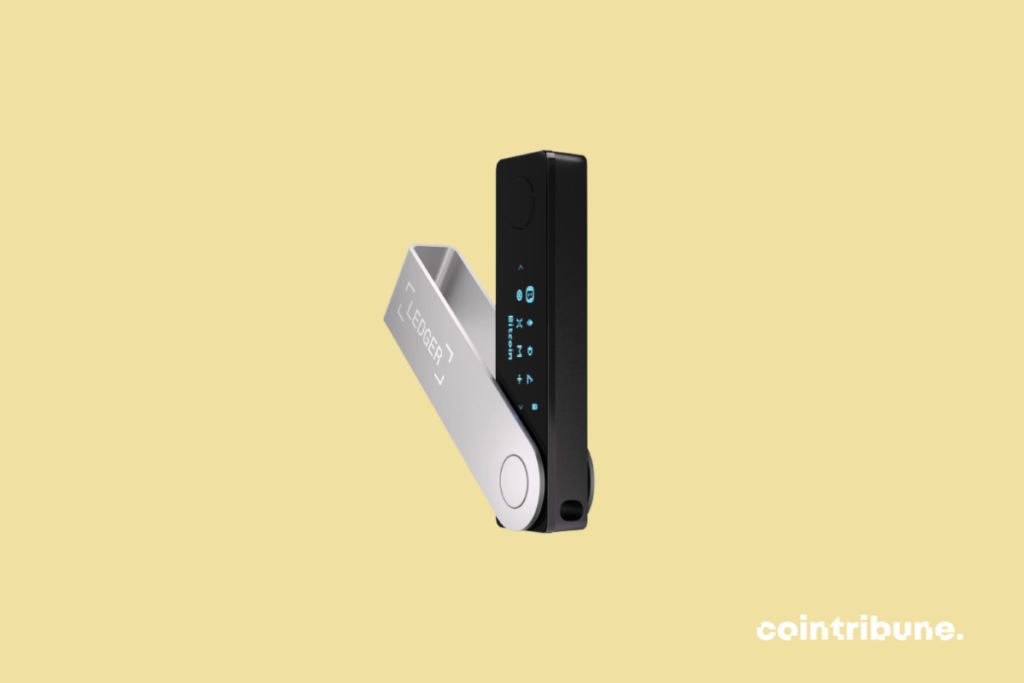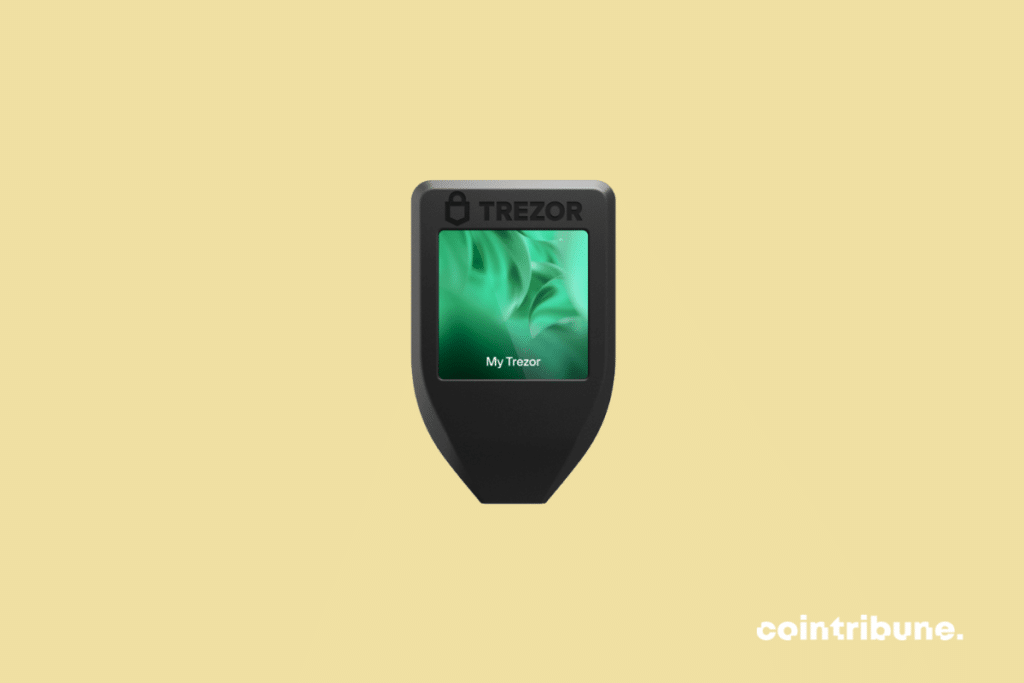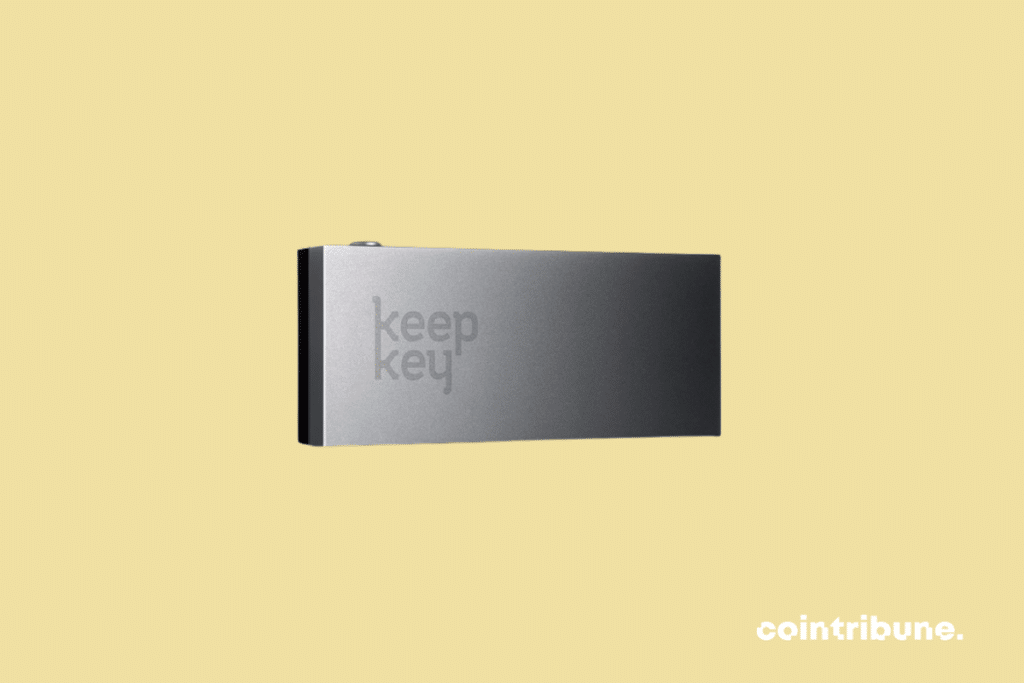Bitcoin Hardware Wallet Reviews: Guide to Securing Your BTC
The security of digital assets is a major concern for investors. That’s why many Bitcoin holders choose to use a hardware wallet, or hard wallet, to store their cryptos with peace of mind. Discover our review of the most popular and effective hard wallets for securing your bitcoins, ethers, and other cryptocurrencies, along with their features, advantages, and disadvantages.

Risks Associated with Online Wallets
Online wallets, such as Metamask, also known as hot wallets, are digital wallets accessible via the Internet. They are easy to use but also present risks for the security of your assets.
To start, hackers can access your wallet and steal your digital currencies if they manage to obtain your login credentials or exploit a vulnerability in the online wallet service.
You may also lose access to your crypto assets if the hot wallet service goes bankrupt or falls victim to a massive hack. Indeed, criminals use hacked hot wallets for money laundering and funding terrorist activities. As a result, even though developers can implement security measures to protect users from hackers, hot wallets remain a risky option due to the inherent characteristics of the technology.
Why Choose a Bitcoin Hard Wallet?
Hard wallets, also known as hardware wallets or cold wallets, are physical devices designed to store your electronic money’s private keys offline. They are essentially safes that keep your digital currency cold and inaccessible to third parties. They often take the form of a smart card or a USB key and their ultimate advantage is their high security.
These crypto wallets offer better security than online wallets such as Zengo or Coinbase Wallet, as they are not exposed to cyberattacks and the vulnerabilities of online services. Additionally, they are generally easier to use than alternative cold storage solutions like paper wallets or steel wallets.
The best solution for storing your digital currencies like Bitcoin in the long term is to opt for hard wallets. In reality, as long as you do not possess the private keys of your virtual money, you are not truly its owner. Hard wallets can come as a smart card or a USB key, like the Ledger Nano X or S, and only the owner has the keys. There are several physical wallets on the market, but here we present the best ones in terms of usability.
How Does a Crypto Hardware Wallet Work?
The operation of a cold wallet is very easy to understand. Indeed, your digital currency is stored offline. Then, with a “PIN code,” you can view your digital currencies and use the wallet properly. Furthermore, it is crucial that the physical wallet is connected to a portable device or a computer to carry out your transactions.
Software that will serve as an interface must be installed on the computer or mobile device. This will allow you to use the wallet and perform transactions from your smartphone or computer. It is through this software that you will access the Internet for your transactions.
You will always receive a request for authorization and confirmation of transactions before any operation. This means that the physical wallet does not connect directly to the internet, thus protecting your digital currencies.
The Best Bitcoin Hard Wallets
In this section, we will examine the best hard wallets available on the market for securely storing your bitcoins, ethers, and other digital currencies. We will specifically present the Ledger Nano X, Trezor One, Bitbox 02, SafePal S1, and KeepKey wallets, highlighting their main features, as well as their advantages and disadvantages.
Here is a comparative table of these 5 best hardware wallets in 2023:
| Hard Wallet | Advantages | Disadvantages | Common Points | Price |
|---|---|---|---|---|
| Ledger Nano X | – Great compatibility with popular crypto assets – Enhanced security with a secure element (SE) and dual verification – Large storage capacity – Mobile app to manage your wallet | – No touchscreen – Mobile app can be a bit complex for beginners | – Simple user interface – Supports over 1500 cryptos | €149.99 |
| Trezor Model T | – Convenient color touchscreen – Enhanced security with a secure element (SE) – Large storage capacity – Mobile app to manage your wallet | – Can be a bit more expensive than other hard wallets – Fewer crypto assets supported compared to some other wallets | – Simple user interface – Supports over 1000 cryptos | €190 |
| KeepKey | – High-resolution touchscreen – Large storage capacity – Enhanced security with a secure element (SE) – Supports hardware wallets | – No support for mobile devices – Does not support as many cryptocurrencies as some other wallets | – Simple user interface – Supports over 40 cryptos | €79 |
| BitBox02 | – Enhanced security with a secure element (SE) – Great compatibility with popular cryptocurrencies like Bitcoin, Ethereum – Mobile app to manage your wallet – Large storage capacity | – No touchscreen – No support for multiple hardware wallets | – Simple user interface – Supports over 1000 cryptocurrencies | €109 |
| SafePal S1 | – High-resolution color touchscreen – Supports multiple hardware wallets – Large storage capacity – Relatively affordable price – Mobile app to manage your wallet | – Does not support as many assets as some other wallets | – Simple user interface – Supports over 500 crypto currencies | €40 |
All of these hard wallets are excellent choices for securing your digital assets. However, there are some differences among these brands that should influence your final decision. For instance, the Ledger Nano X is compatible with over 1500 assets, including Bitcoin and Ethereum. On the other hand, the SafePal S1 supports only about 60 blockchains.
As for the Trezor Model T, its color touchscreen is a practical feature, giving it an advantage over the BitBox02, which lacks one. You should consider these advantages and disadvantages to choose the option that best fits your budget and needs.
Focus on 3 Hardware Wallets
Based on the comparative table provided earlier, a selection of the 3 standout hard wallets has been made. Discover these options, their features, advantages, and disadvantages.
Ledger Nano X
The Ledger Nano X is a popular and versatile hard wallet that offers excellent security and many advanced features. It has 2 buttons and 1 screen for verifying each transaction. It also has a Bluetooth function for connecting your mobile devices.
With its custom BOLOS operating system and CC EAL5+ certified chip, the Ledger Nano X features cutting-edge technology. Ledger wallets are widely recognized as some of the best in the field. With its shape reminiscent of a USB stick, the Ledger Nano X is easy to handle and store. It is not cumbersome and, therefore, very practical.

Main Features
The features of the Ledger Nano X are numerous:
- Support for over 1,800 cryptocurrencies, including Bitcoin, Ethereum, and XRP,
- Ledger Live mobile app for asset management and transaction verification,
- Bluetooth connectivity for easy use with smartphones,
- Integrated OLED screen to display transaction information,
- Satisfactory battery life,
- Adequate storage space,
- Easy to use,
- Very user-friendly device,
- Stainless steel case for enhanced durability.
Advantages and Disadvantages
While it has advantages, the Ledger Nano X also has some disadvantages to consider. Knowing them will help you understand what to expect when using a Ledger Nano X.
Advantages:
- High security due to private key isolation,
- Wide range of supported assets,
- Intuitive user interface with the Ledger Live app,
- Compact and durable design.
Disadvantages:
- Relatively high price compared to other options,
- Bluetooth connectivity may raise security concerns for some users.
Trezor One
The Trezor One is an affordable, user-friendly hard wallet that offers solid security for your bitcoins, ethereum and any other digital currency. It’s just as suitable for newcomers to the cryptosphere as it is for security experts. Available in two colors, it features a two-button click pad and USB-A connectivity. Trezor One is compatible with Android, PC or any browser. One of its advanced features is the secret phrase. You can use a secret phrase for total protection of your digital currencies.

Main Features
Discover the most important features of this hardware wallet.
- Support for over 1,000 cryptocurrencies, including Bitcoin, Ethereum, and Litecoin,
- Integrated OLED screen to display transaction information,
- Web-based user interface for asset management and transaction verification,
- Durable plastic case.
Advantages and Disadvantages
The Trezor One has strengths but also some limitations that still make it an excellent choice.
Advantages:
- Excellent security due to private key isolation,
- Device equipped with a touchscreen,
- Supports nearly 1,000 different cryptocurrencies,
- Compatible with advanced wallets,
- Affordable price compared to other hardware wallets,
- Simple and user-friendly interface.
Disadvantages:
- Fewer cryptocurrencies supported than the Nano X,
- Plastic case less durable than metal options.
KeepKey
KeepKey is an elegant, easy-to-use hard wallet that offers reliable security for your bitcoins and altcoins. It features a simple, elegant display, so you can see straight through every transaction.
Transactions can be approved via a confirmation button, giving you total control over your assets. However, this elegant wallet is bulky in size and shape. These drawbacks aside, it provides great security for your cryptocurrencies.

Main Features
The main features of KeepKey are:
- Support for over 40 cryptocurrencies, including Bitcoin, Ethereum, and Dash,
- Large OLED screen to display transaction information,
- Integration with the ShapeShift app for asset exchanges,
- Anodized aluminum case for enhanced durability.
Advantages and Disadvantages
Here are the pros and cons of the KeepKey hardware wallet:
Advantages:
- Good security due to the isolation of private keys,
- Sleek design and large OLED screen,
- Integration with ShapeShift for easy asset exchanges.
Disadvantages:
- Supports fewer cryptocurrencies compared to the Ledger Nano X and Trezor One,
- Slightly more expensive than the Trezor One.
Beyond the hardware wallets we’ve covered, there are several others such as the secuX V20, Safe T mini, and Ballet Real Bitcoin. To choose the one that best suits your profile, you need to consider well-defined criteria.
Comparison of Different Hardware Wallets Based on 4 Criteria
In this section, we will compare the 3 hardware wallets previously mentioned based on various criteria such as security, ease of use, price, and support for other blockchain digital currencies like Ethereum.
Security
All the hardware wallets examined provide a high level of security by isolating private keys from online environments. The Ledger Nano X and Trezor One have a slightly better reputation for security. The KeepKey also offers reliable security.
Ease of Use
The Ledger Nano X and KeepKey are generally considered the easiest to use, thanks to their LED screens and intuitive user interfaces. The Trezor One is also user-friendly, but its web-based interface can be slightly less convenient compared to mobile or desktop applications.
Price
The Trezor One is the most affordable of the three hardware wallets, followed by KeepKey. The Ledger Nano X is the most expensive but also offers the most features and supports the largest number of cryptocurrencies. The choice depends on your needs and budget.
Cryptocurrency Support
The Ledger Nano X is the hardware wallet that supports the largest number of cryptocurrencies such as ethereum, followed by the Trezor One. The KeepKey supports a more limited number of cryptocurrencies, but integrates the ShapeShift application to facilitate exchanges between supported assets.
What Else Should You Know About Hardware Wallets?
The world of hardware wallets is full of details and key information that you should thoroughly understand. For a complete and in-depth understanding of these essential tools in the blockchain world, here are the essential points to know:
- Even though a hardware wallet is currently the most secure solution available, there is still a possibility of attacks even while using it.
- Using hardware wallets involves a high level of trust in the company that provides them. Even when the code is open source, it’s difficult for most users to understand and verify it, especially during firmware updates. Verification is impossible when the code is not fully open source.
- A hardware wallet is not mandatory if you can securely generate a key pair and have the capability to import private keys into an application that allows signing transactions in a secure environment if you want to spend funds.
- Choosing a hardware wallet offers enhanced protection against attacks. However, a simple firmware update without verification could compromise your seed by introducing malicious code.
What Happens if You Lose a Hardware Wallet?
Once your hardware wallet has been configured, a list of 24 words is sent to you. This process is generally the same with all brands of physical keys. You need to write down these 24 words on a piece of paper and keep it safe. This list will enable you to access your digital currencies on your Ledger or Keepkey, should you forget your pin code or lose your hardware wallet.
Conclusion
In conclusion, hardware wallets are clearly the best option for storing cryptocurrencies. That said, the choice of a Bitcoin hardware wallet will depend on individual priorities, including security, ease of use, price, and the ability to support other cryptocurrencies.
Regardless of which hardware wallet you choose, you should always follow best security practices, such as using a unique PIN code, backing up your recovery phrase, and regularly checking for software updates. Keep in mind that hardware wallets are strictly for digital currencies; you cannot store stocks or other securities on them. For those cases, you should consider soft wallets, following the same rules. Feel free to check out our reviews of Bitcoin soft wallets for more information.
Maximize your Cointribune experience with our "Read to Earn" program! For every article you read, earn points and access exclusive rewards. Sign up now and start earning benefits.
The Cointribune editorial team unites its voices to address topics related to cryptocurrencies, investment, the metaverse, and NFTs, while striving to answer your questions as best as possible.
The views, thoughts, and opinions expressed in this article belong solely to the author, and should not be taken as investment advice. Do your own research before taking any investment decisions.